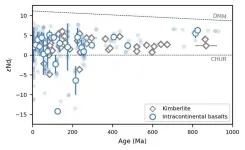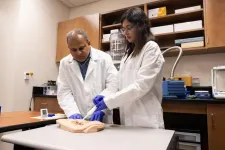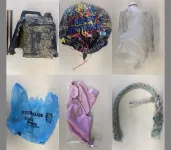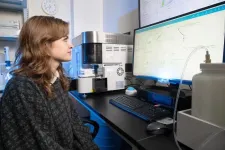(Press-News.org) A study published in the journal Science Advances suggests that global fish farming, or aquaculture, may rely on significantly larger quantities of wild-caught ocean fish than previously calculated. The study is part of a special issue focused on expanding contributions from the aquaculture industry to food systems with an aim towards sustainability.
These findings call into question long-held assumptions about the sustainability of the rapidly growing aquaculture industry and provides a range of plausible estimates for its impact on wild fish populations.
The research, led by an international team of scientists from the University of Miami Rosenstiel School of Marine, Atmospheric, and Earth Science, Oceana, and New York University, provides a reassessment of the "fish-in:fish-out" (FI:FO) ratio for global fed aquaculture—a key metric used to evaluate the efficiency and sustainability of aquaculture.
The findings indicate that the ratio of wild fish inputs to farmed fish outputs is 27% to 307% higher than previous estimates, ranging from 0.36 to 1.15 compared to an earlier estimate of only 0.28. When accounting for wild fish mortality during capture and excluding unfed aquaculture systems, the ratio rises even further to 0.57 to 1.78. For carnivorous farmed species specifically, like salmon, trout, and eel, wild fish inputs likely exceeded twice the farmed fish biomass produced.
"Our study reveals that the aquaculture industry relies more heavily on wild fish extraction than previous research has suggested,” said Spencer Roberts, a doctoral student at the Rosenstiel School in the Department of Environmental Science and Policy, and lead author of the study. “This demonstrates the scale at which aquaculture could be impacting marine ecosystems."
The research team's approach included accounting for previously overlooked sources of wild fish in aquaculture feed, such as trimmings and byproducts from wild-caught fish. They also incorporated collateral fishing mortality, including "slipping"—a practice where unwanted catch is released but a large portion of the animals often do not survive. By analyzing multiple industry-reported datasets, the team provided a range of estimates and highlighted uncertainties in current reporting practices.
"This research shows that the assumptions we have made about carnivorous aquaculture have been too optimistic, and is another reason to think strategically about the kinds of aquatic species it makes the most sense to mass produce,” said Jennifer Jacquet, a co-author of the study and a professor in the Department of Environmental Science and Policy at the Rosenstiel School
The study also examined the environmental trade-offs involved in reducing wild fish use in aquaculture feed. The researchers found that widely-cited estimates of declines in wild fish use from 1997-2017 would require a more than five-fold increase in the use of terrestrial crops over the same period.
Patricia Majluf, Ph.D. a senior scientist with Oceana in Peru, which is home to the largest fishmeal fishery in the world, notes that the growing use of by-products and trimmings has not phased out the capture and use of whole wild fish in feeds for aquaculture. “The offshore aquaculture industry is growing so rapidly that the wild-caught fish is not being replaced in their feed. Instead, other feed sources are just supplementing wild fish use,” states Majluf.
The findings have significant implications for policy-makers, investors, and consumers. The study calls for more comprehensive and transparent reporting of feed ingredients in the aquaculture industry and suggests that policies promoting aquaculture expansion on sustainability grounds should be reconsidered.
Matthew Hayek, an assistant professor in the Department of Environmental Studies at New York University and the study’s corresponding author, stated "It's crucial that we have a more complete understanding of the industry's impact on both marine and terrestrial ecosystems and reduce these uncertainties.” He emphasizes that even with the wide uncertainty ranges reported, the impacts are still larger than previously reported, and “most offshore finfish aquaculture facilities produce carnivorous fish, and therefore are responsible for depleting far more fish from the ocean than what they can produce.”
The researchers stress that while their study provides a more comprehensive view of aquaculture's environmental impacts, further research is needed to fully understand the sector's effects on issues such as nutrient pollution, habitat destruction, and the spread of diseases to wild fish populations.
As the demand for seafood continues to grow worldwide, these findings underscore the urgent need for more transparency in fish farming.
Funding support for this study was provided to Spencer Roberts and Matthew Hayek from the Grace Communications Foundation.
About the University of Miami and Rosenstiel School of Marine, Atmospheric, and Earth Science
The University of Miami is a private research university and academic health system with a distinct geographic capacity to connect institutions, individuals, and ideas across the hemisphere and around the world. The University’s vibrant and diverse academic community comprises 12 schools and colleges serving more than 19,000 undergraduate and graduate students in more than 180 majors and programs. Located within one of the most dynamic and multicultural cities in the world, the University is building new bridges across geographic, cultural, and intellectual borders, bringing a passion for scholarly excellence, a spirit of innovation, a respect for including and elevating diverse voices, and a commitment to tackling the challenges facing our world. With more than $413 million in research and sponsored program expenditures annually, the University of Miami is a member of the prestigious Association of American Universities (AAU).
Founded in 1943, the Rosenstiel School of Marine, Atmospheric, and Earth Science is one of the world’s premier research institutions in the continental United States. The school’s basic and applied research programs seek to improve understanding and prediction of Earth’s geological, oceanic, and atmospheric systems by focusing on four key pillars:
*Saving lives through better forecasting of extreme weather and seismic events.
*Feeding the world by developing sustainable wild fisheries and aquaculture programs.
*Unlocking ocean secrets through research on climate, weather, energy and medicine.
*Preserving marine species, including endangered sharks and other fish, as well as protecting and restoring threatened coral reefs.
www.earth.miami.edu
END
Aquaculture uses far more wild fish than previously estimated, study finds
2024-10-16
ELSE PRESS RELEASES FROM THIS DATE:
Gene editing approach paves the way to first-in-human clinical trial for rare genetic disease
2024-10-16
A collaborative effort between investigators at the National Institutes of Health’s National Institute of Allergy and Infectious Diseases (NIAID) and Massachusetts General Hospital (MGH), a founding member of the Mass General Brigham healthcare system, demonstrates the potential of precise genome editing technologies, called adenine base editors, to correct disease-causing mutations in stem cells from patients with X-linked chronic granulomatous disease (X-CGD), a rare genetic disorder characterized by high susceptibility to infections. The findings are published in Science Translational Medicine.
Patients with ...
Compositional evolution of the upper mantle driven by plate tectonics
2024-10-16
On present-day Earth, plate subduction continuously modifies the chemical composition of the convecting mantle, and various mantle sources linked to these processes have been widely studied.
However, when did global chemical heterogeneity of the convecting mantle first emerge in Earth's geological history? And how might Earth’s geodynamic evolution have influenced the chemical composition of the convecting mantle over time?
Researchers from the Institute of Oceanology of the Chinese Academy of Sciences (IOCAS), along with collaborators from Australia, Switzerland and the USA, have tried to address these questions ...
Virtual reality game used to help students in science classes
2024-10-16
Multilingual students face unique challenges that can hurt their performance in school. New methods of teaching may help close this gap, according to a new study from the University of Georgia.
In the United States, English is the main language used in classrooms. Schools also tend to rely on spoken communication to teach and written exams to assess learning.
That can make it difficult for multilingual students to express themselves. This is especially true in science classes, with their specific terms and complex sentence structures.
So a UGA researcher developed an immersive virtual reality game to communicate scientific ...
Life-saving spongelike “bandage” developed by UCF researchers rapidly stops hemorrhaging and mitigates risk of infection
2024-10-16
Video available here.
Without proper medical invention, injuries sustained from traffic collisions, serious workplace accidents or weapons may result in fatal hemorrhaging.
University of Central Florida researchers aim to prevent such bleeding in potentially deadly situations with a new hemostatic spongelike bandage with antimicrobial efficacy that they recently developed and detailed in a newly published study in the journal Biomaterials Science.
“What happens in the field or during an accident is due to heavy bleeding, patients can die,” says Kausik Mukhopadhyay, assistant professor of materials ...
Model reveals why debunking election misinformation often doesn’t work
2024-10-16
When an election result is disputed, people who are skeptical about the outcome may be swayed by figures of authority who come down on one side or the other. Those figures can be independent monitors, political figures, or news organizations. However, these “debunking” efforts don’t always have the desired effect, and in some cases, they can lead people to cling more tightly to their original position.
Neuroscientists and political scientists at MIT and the University of California at Berkeley have now ...
Project to integrate human and machine intelligence to address information integrity
2024-10-16
Identifying whether online information is faulty or ungrounded is important to ensure information integrity and a well-informed public. This was especially challenging during the COVID-19 pandemic when misinformation spread like wildfire across the Internet. A new project led by Dong Wang, associate professor in the School of Information Sciences at the University of Illinois Urbana-Champaign, will integrate diverse human and machine intelligence to examine multimodal data (e.g., text and image) that was produced during the pandemic. ...
Plastic pollution sounds just like food to deep-diving whales
2024-10-16
BEAUFORT, N.C. -- To whales that hunt with soundwaves in the lightless depths of the ocean, a torn plastic party balloon and a delicious squid seem to be remarkably similar, according to a new study that put some plastic beach trash through underwater acoustic testing.
"These acoustic signatures are similar, and this might be a reason that these animals are driven to consume plastic instead of, or in addition to, their prey," said Duke University graduate student Greg Merrill, who led the research.
"One hundred percent of plastic marine debris ...
Innovating in the corners where atoms meet
2024-10-16
How can we engineer materials that are stronger and lighter? What about new materials for extreme conditions such as in jet engines and spacecrafts?
The answer, says Fadi Abdeljawad, an associate professor of materials science and engineering in Lehigh University's P.C. Rossin College of Engineering and Applied Science, might be hidden in the infinitesimally tiny regions, or boundaries, where atoms in crystals come together.
Along with his collaborators at the U.S. Department of Energy's Center for Integrated Nanotechnologies (CINT), Abdeljawad is uncovering how those ...
Study offers better insights into quality of life for adults with congenital heart disease
2024-10-16
Washington, D.C. (October 16, 2024) – For the first time, adults living with congenital heart disease (CHD) now have valuable insights into their long-term quality of life through data from the Congenital Heart Initiative (CHI). CHI is the nation’s first and largest patient-focused registry for adults with CHD and released its first study involving over 4,500 participants from all 50 states.
This research, published today in JAMA Network Open, marks a significant step forward in making better information available for the ...
Researchers offer alternative to hydroxyurea in study of DNA replication process
2024-10-16
Researchers at Colorado State University have identified an alternate method to study changes during the DNA replication process in lab settings using genetically modified yeast. The new approach offers a clearer window than current drug methods used to understand cell cycle arrest – a fundamental mechanism that is key to treating cancers and genetic issues.
The findings were published in the Proceedings of the National Academy of Sciences and were led at CSU by Assistant Professor Grant Schauer in the Department of Biochemistry and Molecular Biology. The work focuses on hydroxyurea, a chemotherapy drug used ...




